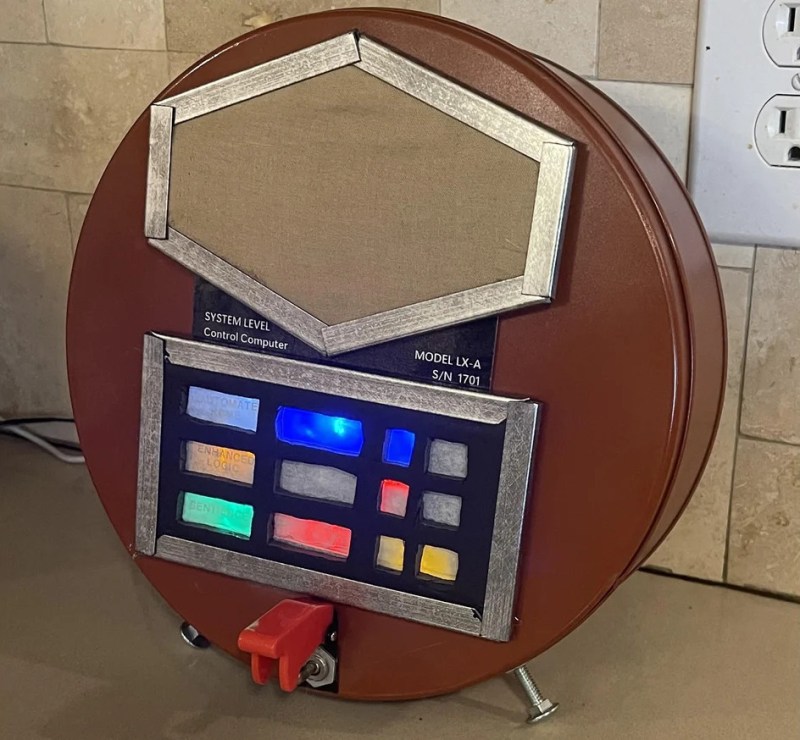Back in the last century, especially in the ’40s to the ’60s, one of the major home decor trends was to install various home appliances, like the television or stereo, into its own piece of furniture. These were usually bulky, awkward, and incredibly heavy. And, since real life inspires art, most of the futuristic sci-fi technology we saw in movies and TV of the time was similarly conspicuous and physical. Not so with modern technology, though, where the trend now is to hide it out of the way and forget it exists. But [dermbrian] wanted some of his modern technology to have some of the mid-century visibility aesthetic so he made some modifications to his Amazon Echo.
The Echo itself remains largely unmodified, other than placing it inside a much larger cookie tin with some supporting electronics. For that, [dermbrian] found a relay board with a built-in microphone which switches the relay off when it detects sound so that when the Echo is activated, the sound from its speaker activates the module. From there it drives a series of blinkenlights which mimic the 60s computer aesthetic. Some custom fabrication and light diffusion methods were needed to get it to look just right, and a switch on the outside can disable the mechanism if it is getting triggered by background noise like music from his stereo.
While the appeal of this style may be lost on anyone who wasn’t a fan of the original Lost in Space, Star Trek, or Jetsons, it certainly holds a special significance for those who grew up in that era. It’s certainly not the first project we’ve seen to take a look back at the aesthetics of bygone eras, either. Take a look at this project which adds lenses to modern displays to give them the impression of antiquated CRT displays.

















Dr. Theopolis.
Wow, completely forgot about Theo, thanks!
ORAC
biddi-biddi-biddi I wasn’t the only one that thought this Buck!
I came to these comments to say the same thing.
I’m the biggest fan of these steampunk and retro projects and this one is really well executed. It took me a while to figure out that it’s a spray painted cookie tin, which is brilliant
It looks Klingon to me.
Thankfully you only have to talk to this and not touch the sheetmetal edges of the non-mitered joints. The blinkenlights look crudely cut out. I have 2 1920’s radio floor consoles case only. Once we got over the wires and breadboards newness console furniture came about. These had turned legs and carvings, by the late 30’s moderen and art-deco changed things again.
These devices react to my name. I have to be cautious around one.
Might you have a Twonky?
https://www.prosperosisle.org/spip.php?article870
“Back in the last century, especially in the ’40s to the ’60s, one of the major home decor trends was to install various home appliances, like the television or stereo, into its own piece of furniture. These were usually bulky, awkward, and incredibly heavy. ”
This wasn’t a fashion choice – It’s not like there were a bunch of wall-sized, 250 gram flatscreen alternatives around. The only way these devices made into the profitable “home appliance” category at all was to encase them and make them “portable” to the extent that they didn’t need a dedicated connection to mains power and a massive cooling system. Yes, you might need a dolly or a couple of beefy helpers to “port” them anywhere, but they could be sold into the house and used there. The furniture built around them was also to keep little fingers out of the high voltage/high temperature parts and not annoy the owners’ sensibilities with the point to point chassis’ birds nest of wires.
Polemics aside, Matt Jeffries et al. would enjoy this project, though the 1701 s/n is a bit much.
> “the trend now is to hide it out of the way and forget it exists”
Is that a “trend” or the manufacturers trying to make us forget that we have put their microphones into our homes to listen to everything we say?